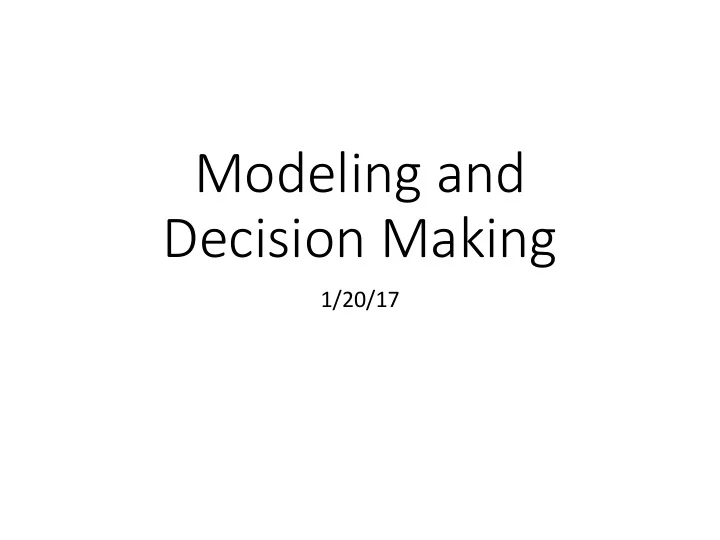

Modeling and Decision Making 1/20/17
Modeling Dimensions • Discreteness • Planning horizon • Observability • Uncertainty • Dynamism • Number of agents
Discreteness • Does the agent model the environment as: • Discrete • Some software agents may truly live in a discrete world. • Continuous Temperature is continuous, • The real world is continuous, but a discrete but a discrete state model model can often improve agent reasoning. simplifies the thermostat. • Discrete and continuous modules can co-exist, e.g. discrete route planning and continuous States: • Too cold motor control. • Comfortable • Too hot
Planning Horizon • non-planning Different components of the • thermostat same system may operate • fixed finite horizon on different horizons. • tic-tac-toe player This difference is • indefinite finite horizon an adaptation to computational • chess player constraints. • infinite horizon • smart home
Observability Does the agent know everything about the world that is relevant to its decisions? Full observability • Bird’s eye view of a maze • Chess Partial observability • Agent dropped into a maze • Poker
Uncertainty When an agent acts, does it know all the consequences of that action? In deterministic environments • Agents can make a plan they know will succeed • Optimize for the simplest or cheapest plan In uncertain environments • Agents may need contingent plans • Agents may need to reason probabilistically • Consider risk/reward and optimize expected outcomes
Dynamic Environment • If the world is modeled as static, we assume that the environment only changes as a result of the agent’s actions. • In a dynamic environment, the world can change on its own. How is this different from uncertainty/observability?
Number of Agents Additional agents can be modeled as: • part of the environment • This will always make the environment dynamic. • competitors • The agent will need to reason about their intentions with game theory. • collaborators • The agent may be able to offload some of its physical or computational work on others. • The agent may need to assist other agents.
How should we model these environments? Is the one agent? Do actions have Is the Is the world What is the Is the If there are many, deterministic or environment are they discrete or planning environment fully uncertain static or continuous? horizon? observable? cooperative or consequences? dynamic? competitive? Rubick‘s cube Mars rover stock trading
Frameworks for Decision-Making 1. Goal-directed planning • Agents want to accomplish some goal. • The agent will use search to devise a plan. 2. Utility maximization • Agents ascribe a utility to various outcomes. • The agent attempts to maximize expected utility.
Goal-Directed Planning Examples: • Lab 0: maze search • Lab 1: heuristic search • Lab 3, 4: game playing Approach: • Search for a sequence of actions that achieves a goal.
State space problems have • A set of discrete states • A distinguished start state • A set of actions available to the agent in each state; • An action function that, given a state and an action, returns a new state • A set of goal states , often specified as a function • A way to measure solution quality
Utility Maximization Examples: • Lab 2: optimization/local search • Lab 4/5: nondeterministic planning Key ideas: • Assign utility value to various outcomes • Reason about the probability of each outcome occurring • Maximize expected value
Utility considerations Planning horizon: does the agent get utility at the end, or accumulate it along the way? • Discounting Expected value: • Act in a way that maximizes the sum over outcomes of the probability of that outcome times its utility.
What are the advantages and disadvantages of each framework for these tasks? Goal-directed planning Utility maximization Rubick‘s cube Mars rover stock trading chess playing
Recommend
More recommend